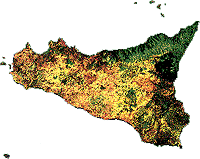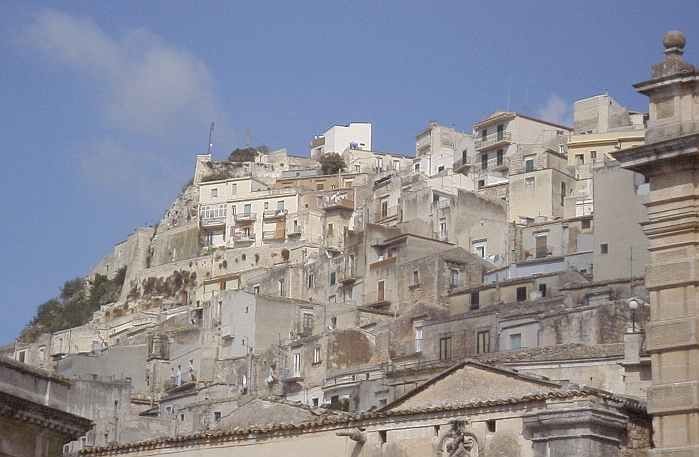
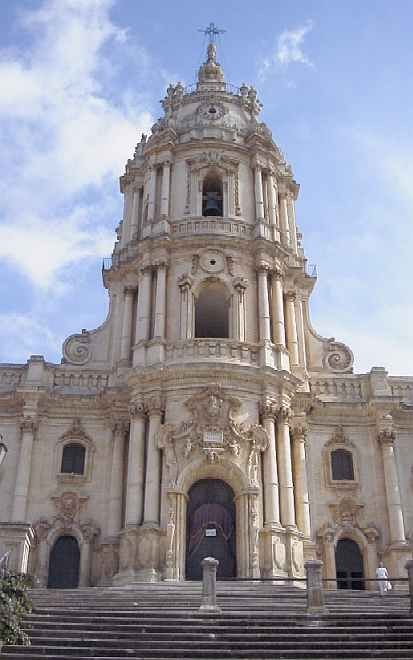 At the top of 300 stairs rises
the baroque jewel of St. George Cathedral
At the top of 300 stairs rises
the baroque jewel of St. George Cathedral
Long before we made any plans for Sicily we had decided to journey to Modica, lured by an International Herald Tribune article that raved about this simple "chocolate mecca of Sicily" which was relatively free of tourists. Because of the convergence of the Spanish influence (who brought the beans from the new world) and the Arabs, Modica was perhaps the spot where Europeans created the chocolate bar.
We started for Modica Saturday morning after acquiring the rental car and taking what seemed like hours to get out of Cantania. Whatever road we wanted to take in town was either closed or a Carabinieri directed us elsewhere. Finally we got onto the Sicilian country roads which are really pretty good and well marked and came through white stone-fenced backroads into the Modica valley. These fences were built by clearing the limestone rocks from the fields and having specially trained masons construct them. They go on for miles and miles.
The Modica is divided into two with each part clinging tightly to steep mountainsides. The picture below shows the upper town with a bit of the castle at top. The roads are as steep as you might imagine from this shot.

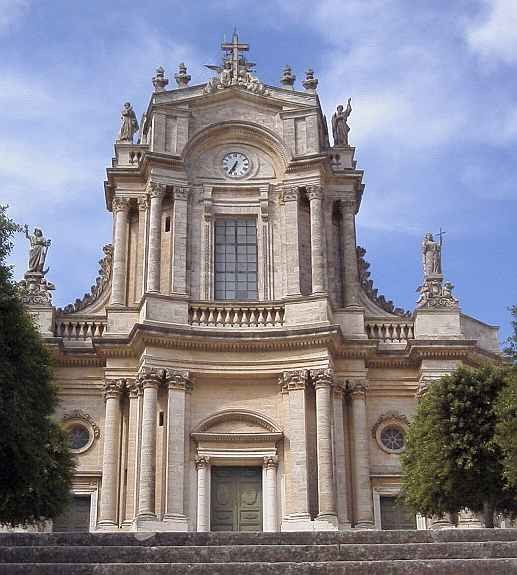
We pulled into the lower town and walked a block to St. Theresa's church where one of the congregation greeted us inside. Two blocks later, we found St. John's shown just above (but locked). All the natives were very helpful with, I'm sure, very clear directions but only in Italian. We were learning the good and bad points of a town not having many tourists. Maps, English speakers, and street signs are not needed if you don't have a lot of tourists.
Eventually we asked directions of a Moroccan teenager (yes, a door-to-door salesman of rugs, I am not making this up) who walked us to our first intended destination, the Cathedral of San Giorgio shown at the top of this page. He was a talkative young man who knew about four languages, but none of them English. He wouldn't take a tip for his trouble no matter how much I insisted but eventually tried to sell me a shirt. Given how steep these hills were, I wasn't about to take on any more baggage.
San Giorgio turned out to be as beautiful as expected. The 1693 earthquake in this part of the Sicily had wiped out most traces of Normans, Arabs, Greeks, and whoever else tromped through in the previous two millennia. As the nearby towns of Modica, Noto, Ragusa rebuilt, the architecture de jour was baroque.
San Giorgio is even more impressive than the picture because it sits atop nearly 300 steps which wind their way up to it through gardens somewhat in a state of disrepair.
But San Giorgio was not without its surprises. Inside the church, we found a casket at the heart of the church. Behind another screen, waited another casket. Apparently the Modicans do not use funeral parlors but use the church instead. (Death is taken quite seriously in Sicily as we noticed by all of the obituary notices, not put in newspapers, but instead papered on walls like billboards.)
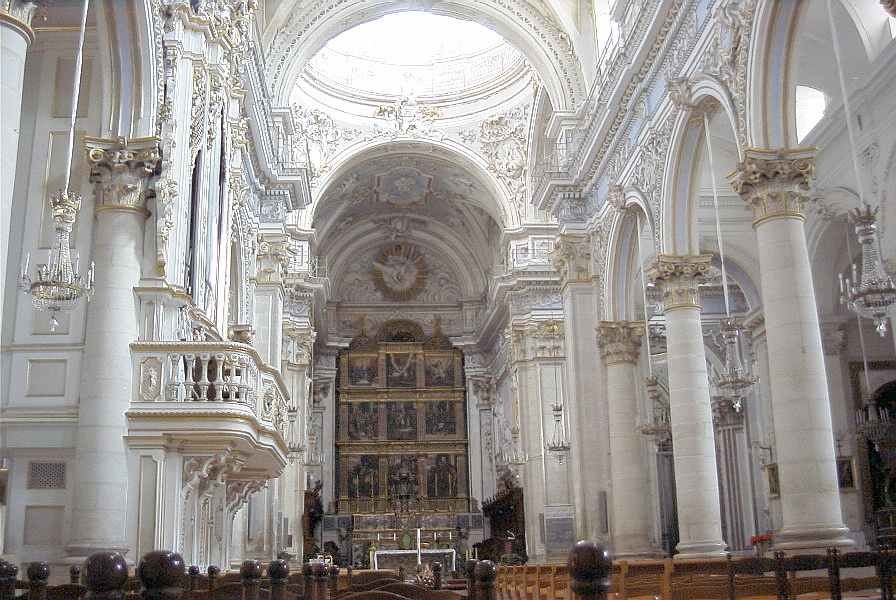
Perhaps you can see a bit of the casket at the center of the picture in front of the 3 layer silver altar screen older than the church (1513) which is shown in a close-up below:
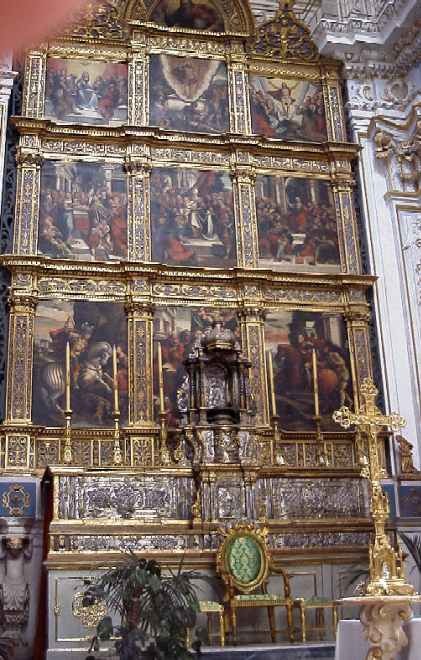
After a bit of lunch literally in the shadow of the Cathedral overlooking the valley, we wound our way down to the main road. On the way, we crossed in front of another Baroque church which was unfortunately closed. It is St. Peter's and you can see some of the statues of the apostles in front of it.
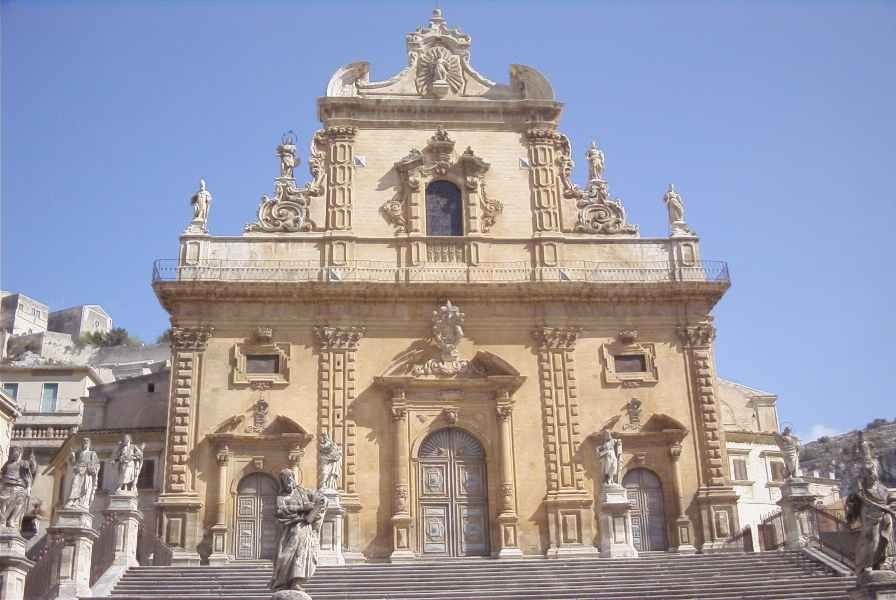
Modica was built where two rivers come together and was linked by 20 bridges giving it the nickname of "Venice of the South." But in addition to earthquakes, Modica suffered severe floods. After the 1902 flood, the waterways were sealed off and roads replaced them. This puts the main drag at the very bottom of the city which rises like very steep gull wings above it.
We fairly easily found our Chocolate store and it was every bit as quaint as the Herald Tribune had said it would be (and the clerk knew English and explained what each of the chocolates were for, etc. This made the Japanese couple next to us in line feel better too!)
Coming out is when the fun began. We started walking up the hills only to become immediately lost and tired. The hike did not seem all that different from climbing out of the Grand Canyon a few years earlier except this time the path was paved -- but not much wider. (In the Grand Canyon you can't get lost since there is only one road and you are either going up or down. Not the case in Modica) Townspeople kept coming out of houses to try to redirect us (including an Sicilian from Cleveland who had seen us on the main drag; he told us to go back down and get a bus or cab). When we got back to the bottom, we found that all the cabs were out to lunch and not to expect them back for several hours.
Finally we stumbled back to our car and were off to the Southern seashore to a beautiful resort area called Marina di Ragusa where we spent a night walking back and forth on the Mediterranean shore. The next morning, we were off to our last stop: Noto. Please join us at this Baroque town by clicking here.
PS. We got back home and found 1) the chocolate was different from what we were used to and not quite to our taste and 2) the candy store has a web page and will ship us all of the chocolate we want! It's the L'Antica Dolceria Bonajuto, at http://ragusaonline.com/bonajuto/_index.htm. Enjoy!
Where do you want to go today? Here's a few choices:
